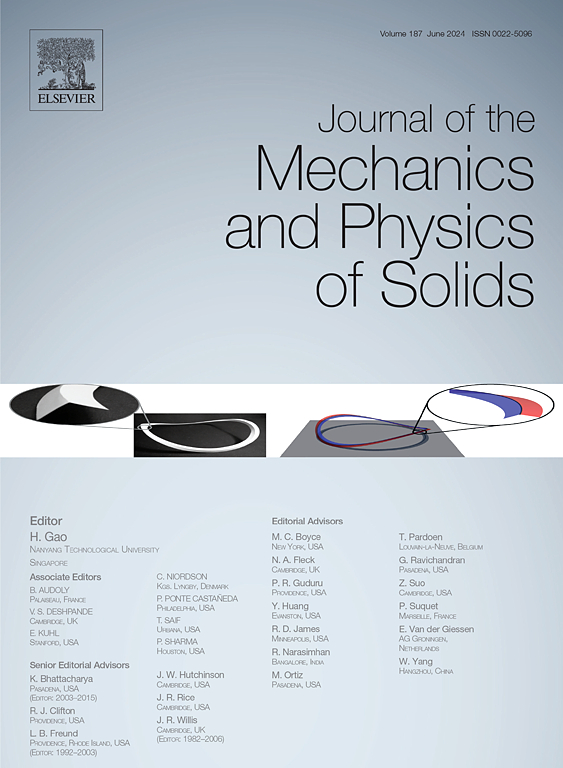A unified morphomechanics theory framework for both Euclidean and non-Euclidean curved crease origami
IF 5
2区 工程技术
Q2 MATERIALS SCIENCE, MULTIDISCIPLINARY
引用次数: 0
Abstract
Conventional curved crease origami exhibits only Euclidean metrics at the crease, where the surfaces on either side should consistently display convexity on one side and concavity on the other, unfavorably leading to restricted morphologies. Herein, we focus on a special type of origami: non-Euclidean curved crease origami. Additionally, we establish a morphomechanics framework that facilitates the morphology calculation for curved crease origami with arbitrary crease metrics. Specifically, starting with a unified geometric description, it is demonstrated that this non-Euclidean curved crease origami exhibits a broader range of unique morphologies: the convexity and concavity of surfaces can be globally consistent, globally opposite, or vary locally. Additionally, we propose two in-situ reconfiguration strategies: adjusting the folding angle or modifying the sections corresponding to specified angles. Existing calculation methods for designated deployment paths are extended to include non-Euclidean curved crease origami, emphasizing the role of the interfering section in determining deformation limits. Most importantly, we develop a new discrete developable patch model, enabling accurate calculation of the morphology of both Euclidean and non-Euclidean curved crease origami under free deployment paths. Both theoretical and physical models demonstrate the exclusive advantages of complex and diverse morphologies of non-Euclidean curved crease origami, which can be interconverted through two independent reconfiguration strategies. This work broadens the design scope of curved crease origami and provides a systematic framework for subsequent design and theoretical analysis, offering insights for future morphological calculations and active morphology control.
求助全文
约1分钟内获得全文
求助全文
来源期刊
CiteScore
9.80
自引率
9.40%
发文量
276
审稿时长
52 days
期刊介绍:
The aim of Journal of The Mechanics and Physics of Solids is to publish research of the highest quality and of lasting significance on the mechanics of solids. The scope is broad, from fundamental concepts in mechanics to the analysis of novel phenomena and applications. Solids are interpreted broadly to include both hard and soft materials as well as natural and synthetic structures. The approach can be theoretical, experimental or computational.This research activity sits within engineering science and the allied areas of applied mathematics, materials science, bio-mechanics, applied physics, and geophysics.
The Journal was founded in 1952 by Rodney Hill, who was its Editor-in-Chief until 1968. The topics of interest to the Journal evolve with developments in the subject but its basic ethos remains the same: to publish research of the highest quality relating to the mechanics of solids. Thus, emphasis is placed on the development of fundamental concepts of mechanics and novel applications of these concepts based on theoretical, experimental or computational approaches, drawing upon the various branches of engineering science and the allied areas within applied mathematics, materials science, structural engineering, applied physics, and geophysics.
The main purpose of the Journal is to foster scientific understanding of the processes of deformation and mechanical failure of all solid materials, both technological and natural, and the connections between these processes and their underlying physical mechanisms. In this sense, the content of the Journal should reflect the current state of the discipline in analysis, experimental observation, and numerical simulation. In the interest of achieving this goal, authors are encouraged to consider the significance of their contributions for the field of mechanics and the implications of their results, in addition to describing the details of their work.

 求助内容:
求助内容: 应助结果提醒方式:
应助结果提醒方式:


